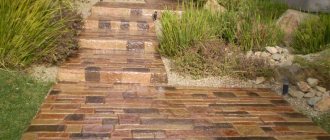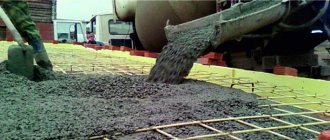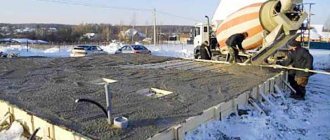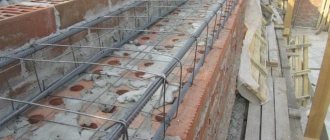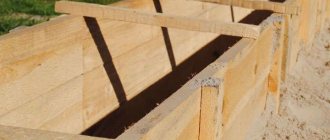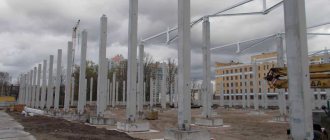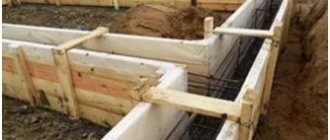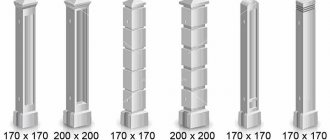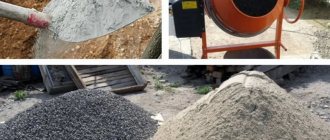Proper pouring of concrete into formwork is the key to beauty, quality and the best performance characteristics of the future structure. Most often, these works are carried out at the initial stage of building construction, becoming the basis of the structure. And how reliable the foundation or floors will be and meet the required parameters depends precisely on the pouring of cement into the monolithic structure.
Basic conditions for high quality work: pouring technology must be followed, the best and appropriate materials must be used. The choice of the correct formwork design depending on the task at hand (type of structure, method of supplying mortar, volume of concreting), and the use of tools and devices are important.
Formwork is a panel structure that is made from different materials and is used to pour concrete inside, which in the future will act as a load-bearing element of the building. Metal frames are usually installed inside the formwork to strengthen the concrete and give it the desired characteristics. It is quite possible to do all the work yourself, having first studied the technology and selected everything you need.
What types of removable formwork are there?
Before pouring concrete into the formwork, you need to decide on the type of panel structure. Removable formworks are made in the form of a panel fence from a certain material. The main element of the formwork is the internal volume intended to be filled with cement mortar. Metal rods or meshes are also placed here to ensure the strength of the entire structure and high load resistance of the concrete product.
The construction of houses requires strict adherence to the rules for constructing formwork, on which the operational characteristics and characteristics of the hardening of the mass will depend. Removable formwork can be made of laminated plywood, wood, plastic, metal. The main advantage of this type of design is the possibility of its reusable use.
According to the design of the formwork there are:
1) Beam systems - constructed from formwork slabs, crossbars, beams, retaining elements and fasteners
2) Frame systems - formworks are made of panels, supporting posts and fasteners connecting them
Requirements for formwork:
- Dimensions and configuration made according to working drawings
- No cracks, holes, sufficient rigidity
- The strength of the shields that will withstand the pressure of concrete and will not allow it to come out
- Smooth, flat inner surface
For precise installation, building levels and plumb lines are used, they strictly follow the drawings, and they are reinforced with special spacers, clamps, and supports. To determine the height of the concrete layer, a cord is attached to the top of the reinforcement inside the formwork.
Formwork for concrete - types, materials, installation technology
Formwork for concrete
Formwork is a hollow form, the internal volume of which is filled with concrete during the construction of monolithic structures: foundations, walls, ceilings, columns.
To this day, one of the oldest technologies is used for pouring mortar into a dug earthen trench, which is also formwork.
Removable and permanent formworks are used in construction. One of the main advantages of removable formwork is the possibility of reusing it. Removable formworks for pouring concrete are made from a variety of materials - wood, laminated plywood, metal, plastic and differ in design:
- frame system consisting of panels, supporting posts and fastening elements;
- beam system, which includes formwork slabs, beams, crossbars, supporting elements, and fastening parts.
Mandatory requirements for concrete formwork:
- the strength of the material from which it is made - to protect the structure from deformation;
- smoothness of the inner surface of the formwork - for easy removal after pouring and drying concrete, as well as to reduce the cost of subsequent wall finishing;
- absence of gaps in the structure - to avoid concrete leakage when pouring mortar into the formwork.
To accurately install concrete formwork in a vertical position, plumb lines, magnetic or water levels are used. The formwork, carefully installed in accordance with the drawing, must be strengthened with special clamps, spacers, and support posts. Its internal volume is filled with reinforcement to enhance the strength of the future structure. To determine the height of pouring concrete into the formwork, a cord is attached to the top of the reinforcement.
Types of formwork
Concrete can be poured directly into the ground, without formwork - simply dig a trench in the ground and pour cement into it. This option is suitable for constructing a strip-type foundation with the ability to withstand not very heavy loads.
But the most popular formwork option for pouring concrete is the production of a collapsible structure from wooden panels, which are assembled with fasteners, then the timber is installed. The planed side of the formwork board is turned inward so that the monolith is smooth. After dismantling the formwork, the boards can be used again in pouring concrete or for other needs.
Construction plywood with laminated side surfaces is also used. It is also assembled with shields, secured on the outside with bent metal rods. The equipment is made of metal, mounted and dismantled using a truck crane.
Metal formworks are produced by enlarging panels into mounting panels using a lifting mechanism. The parts are assembled and fixed with bolts and welds. To prevent concrete from sticking when pouring, the inside of the structure is lubricated with a special emulsion.
Often, mobile formwork is used to pour concrete, which is suitable for the construction of multi-level walls of a structure. During the process of concrete hardening, the metal panels are dismantled and moved further higher in level. Typically, such options are chosen for residential and industrial construction.
Formworks manufactured in industrial conditions require strengthening of the working planes and are equipped with improved fastening systems to speed up installation and dismantling. In this way, it is possible to increase the speed of construction several times, which is important for frame-based structures.
Sometimes the use of permanent polystyrene foam formwork is required. The design is a box without a bottom and a lid, in which internal partitions are installed to ensure the required level of rigidity when pouring.
Formwork materials
A variety of materials are used to make formwork for strip foundations. However, when choosing, you need to take into account the basic requirements for formwork systems; they determine the need to use certain materials:
- Bending resistance. The permissible deflection of the panels when pouring the concrete mixture should not exceed 2 m.
- Rigidity. The elements from which the structure is assembled must be properly connected to each other.
- Smoothness of shields. Differences in level on the surfaces of the boards should not be more than 2 mm. The same requirements apply to the connection points of the shields.
- Geometric accuracy. The material of the shields should not be prone to warping when in contact with moisture.
Metal
Metal is a suitable material for strip foundation formwork. But it is used mainly in professional construction, since it is quite expensive. To assemble the molds, rolled sheets up to 2 mm thick are used.
This material makes it possible to produce shapes of complex configurations, for example, semicircular ones. Metal formwork can be removable or permanent. In the latter case, the reinforcement is welded to the formwork forms, which increases the strength of the structure.
Reinforced concrete
The use of reinforced concrete slabs for formwork under the foundation also requires additional financial costs. Depending on the thickness of the slabs, the amount of concrete solution can be reduced when pouring.
The presence of stationary reinforced concrete formwork will allow you to maintain the strength characteristics of the cast structure even if the thickness of the main part is reduced. The disadvantage of this option is the impressive weight of the slabs, which makes it necessary to use lifting equipment.
Expanded polystyrene
Foam permanent formwork for a strip foundation is a practical option. The molds are assembled quickly because they are light in weight and easy to move by hand. In addition, this material perfectly functions as a heat insulator.
The disadvantages include not being flawless from an environmental point of view; nevertheless, expanded polystyrene is a material of artificial origin. Another significant negative point is that the material releases toxic substances when heated, which is extremely dangerous in the event of a fire.
Wood
When planning to make formwork for the foundation with your own hands, many choose wood as a material. This is an affordable and easy-to-process material. Shields are knocked together from boards and timber, then you will need to seal the cracks and prepare spacers.
Adjustable formwork is made from wood; this material is not suitable for creating permanent forms.
Available materials
To make formwork for a strip foundation with your own hands, you can also use available materials. As a rule, sheet material is used. For example, corrugated sheet or slate. The only advantage of this solution is its low cost, but there are many disadvantages, in particular:
- complexity of assembly, fastening sheets of slate together is not at all easy;
- low load resistance;
- the need to install a large number of additional spacers.
Preparing for pouring
Before attaching the foundation formwork for pouring concrete, it is necessary to perform a number of preliminary measures: prepare tools, mortar, and a platform. Concrete for pouring is selected in accordance with the required characteristics and time of year, soil characteristics (freezing depth, heaving, groundwater level). In order to increase strength, they are reinforced with metal reinforcement, the quantity, diameter and pitch of which are selected in accordance with the characteristics of the soil and climate.
Concreting can be done with a solution prepared independently from cement, sand, crushed stone and water, or from a ready-made dry mixture. You cannot skimp on the quality of materials; you need to prepare it in a concrete mixer. The following tools and devices are used for work: a shovel, a hammer, measuring instruments, a concrete mixer and containers for measuring mixtures, a sledgehammer, a vibrating machine or a bayonet for tapping the formwork.
First, the formwork is assembled, installed, secured, and position adjusted. The geometry of the enclosing structures must be ideal, the walls must be vertical, and there must be no gaps in the joints through which concrete can leak out when pouring. The diagonals between opposite corners should not differ by more than 30 millimeters maximum.
After installation, the concrete formwork is thoroughly cleaned inside so that there is no dirt and debris, then the reinforcement is laid. The frame must be equipped with clamps that do not allow the mesh rods to touch the surfaces on the sides and bottom. Fix the cord on top (checking the evenness with a building level) and fill it along it. Next, the formwork is filled with mortar around the perimeter, allowed to gain strength, and the panels are dismantled.
Preparation and pouring of liquid concrete
The filling solution is ordered from suppliers or prepared independently. Cement grades below M200-300 are not used. High-strength concrete is prepared according to the recipe: 1.5-2 parts sand per part M400 cement, 2.5-3 parts crushed stone. If the strength should be average, the solution can be made in the following proportion: part M400 cement and 3-8 parts of a mixture of gravel and sand. The resulting concrete should not spread over the shovel.
Concrete for pouring can be prepared in different ways, depending on production volumes and structural features.
Mortar unit
If we are talking about large-scale construction, it is easier to prepare the mixture automatically: sand and crushed stone are poured into a mixing container, water and cement are supplied using special dispensers, and the finished mixture is delivered from the bunker to the back of a special vehicle. It is enough to submit an application indicating the time, brand of concrete and volumes, so that the machine delivers the mixture for pouring to the site.
Automixer
A concrete mixer truck is a special vehicle with a rotating drum. All components for concrete are loaded into it; during transportation, the mixture in a rotating mixer goes through all stages of preparation, maintaining fluidity. At the construction site, the mixer delivers the liquid mixture using the pouring method using a pump and hose. If there is no access to the work site, concrete is loaded into special bunkers, and then the container is delivered by crane to the site for pouring.
Concrete mixer
The device is used when performing small amounts of work. This is a regular pear-shaped stirrer that rotates. It holds about 150 liters of mixture, which is loaded with components using a shovel with preliminary weighing of the required volumes. It is cheaper than special types of vehicles, but involves faster and less labor-intensive work than manual mixing.
Manual method
If you need to prepare concrete for pouring (a mixture whose volume is small - if you are making a foundation for a greenhouse, barn, additional structures), this method is relevant. Load the ingredients in the required volumes into a suitable container and mix with a shovel until the correct consistency is obtained.
Pros and cons of using mixers
According to SNiP 3.03.01, the concrete mixture is laid so that each subsequent layer rests on a surface that has not yet hardened. If the supply of material is interrupted for more than an hour and the strength has reached 1.5 MPa, it is allowed to continue pouring after wetting with water and priming with cement laitance.
Pouring concrete is a rather complex and lengthy process. The choice of raw materials for work falls on the owner of the building. Experts advise using mixers, the advantages of which are as follows:
- completing the filling in a few hours;
- high quality building materials;
- the consistency of the material is more convenient for laying and leveling;
- no calculations required to prepare the solution;
- the presence of special additives and plasticizers that improve the waterproofing ability of the material;
- homogeneity of the structure, achieved by mixing in a concrete mixer during transportation.
To calculate the possibility of access to the construction site, the dimensions of the vehicle are taken into account.
Concrete is fed from the mixer along a special belt. But laying such material has its drawbacks. Ordering concrete delivery to a construction site using a mixer has a fairly high price. And the inability to drive to hard-to-reach areas by car makes this method less accessible. Therefore, before ordering an automated concrete mixer, you need to prepare an entrance or rent a concrete pump, with which you can pour the solution into areas inaccessible to special equipment.
Compaction and drying process of concrete
During the process of pouring concrete into the formwork, each layer with a maximum thickness of 20 centimeters must be compacted. For this, manual submersible vibrators are usually used, which promote uniform distribution of the layer over the surface and allow air to escape. After compaction, the vibrator is removed without turning off so that a void does not appear under its cylinder. If there is no vibrator, remember the method of bayoneting the mortar; you can release air by tapping on the formwork panel.
Improper drying of concrete can cause cracks and deformations, which may then require repair of the mixture, which increases the completion time and cost of the work. Concrete takes up to 28 days to dry; at first it must be moistened with water. Much depends on the time of year.
Curing
In summer, concrete should be covered with plastic wrap and watered every 4 hours for the first 3 days with water by spraying. Then they water it every day for another week (more often if it’s hot), after 10 days the formwork can be dismantled, after 28 days the concrete will have fully gained its strength.
It is better not to carry out work in winter, but if it is really necessary, the concrete must be protected from freezing and provided with a temperature of at least +3C - you can use heat guns, electric heating, insulation, and special frost-resistant additives. The formwork must be insulated until the concrete reaches at least 50% strength.
Depending on the requirements for the concrete base, one or another type of formwork is chosen. Thus, when building a bathhouse or sauna, for swimming pools and greenhouses, residential and industrial buildings, completely different types of structures will be needed to allow pouring to be carried out in accordance with established standards and requirements for the future monolith.
If preliminary calculations are carried out correctly, all necessary equipment and tools are used, quality materials are selected, pouring concrete into the formwork with your own hands will provide the desired result.
Pouring stages
A concrete pump is used to unload the solution over a long distance.
In order to take concrete from the mixer, it is necessary to invite assistants, because the work needs to be done quickly, since the driver of the special equipment can rush to the next object. The material is laid in the following sequence:
- Taking the solution. The concrete mixture from the mixer is fed through a special metal tray, which is equipped with special equipment. To supply concrete over a distance of more than 4.5 m, chutes or a concrete pump are used.
- Distribution. Workers use a shovel to evenly distribute the mixture over the formwork. This is necessary to reduce the manipulation of the vehicle and its movements around the construction site. The car together with the solution has a lot of weight and can damage the integrity of the pit.
- Compacting. The concrete mixture has a large number of air bubbles, which form pores when hardened. This reduces the strength of the structure. Therefore, the distributed solution is compacted using electric construction vibrators.
- Alignment. It is carried out according to the previously applied markings. To do this, use a trowel or other suitable tool. To achieve a more even surface, the fishing line is pulled level in accordance with the markings.
If it is not possible to pour concrete into the formwork directly from a mixer, experienced craftsmen recommend pouring the mixture onto plastic film so as not to lose the liquid, which helps harden the material.
The work of laying building materials from a concrete mixer takes several hours, which makes the structure stronger and more durable. Do not forget about caring for the concrete surface. To prevent the water from drying out from the solution, the filled surface is covered with polyethylene and sprayed with water for 2-3 days. The formwork is removed after 2 weeks. Properly performed work will ensure the quality and reliability of the structure.
